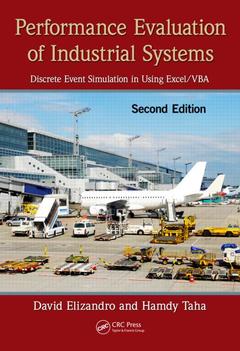Description
Performance Evaluation of Industrial Systems (2nd Ed.)
Discrete Event Simulation in Using Excel/VBA, Second Edition
Authors: Elizandro David, Taha Hamdy
Language: English
Subjects for Performance Evaluation of Industrial Systems:
Keywords
Discrete Event Simulation; Cycle Time; Simulation Modeling; Service Completion; Network Representation; Interarrival Time; Modeling Procedures; Delay Node; Analysis of Simulation Results; Facility F1; Supply Chain Logistics Models; VBA Code; Queue Length; Customers Arrive; Simulation Languages; Simulation Clock; Simple Queueing Model; Workstation Cycle Times; Source S1; AGV; Queue Discipline; VBA Environment; Average Queue Length; VBA Function; Downstream Queue; Performance Metrics; Run Length; Simulation Program; Replication Method; Output Spreadsheets
504 p. · 17.8x25.4 cm · Hardback
Description
/li>Contents
/li>Readership
/li>Biography
/li>
Basic approaches to discrete simulation have been process simulation languages (e.g., GPSS) and event-scheduling type (e.g., SIMSCRIPT). The trade-offs are that event-scheduling languages offer more modeling flexibility and process-oriented languages are more intuitive to the user. With these considerations in mind, authors David Elizandro and Hamdy Taha embarked on the development of a new discrete simulation environment that is easy to use, yet flexible enough to model complex production systems. They introduced this environment, Design Environment for Event Driven Simulation (DEEDS), in Simulation of Industrial Systems: Discrete Event Simulation in Using Excel/VBA. The DEEDS environment is itself an Excel/VBA add-in.
Based on this foundation, the second edition, now titled Performance Evaluation of Industrial Systems: Discrete Event Simulation in Using Excel/VBA incorporates the use of discrete simulation to statistically analyze a system and render the most efficient time sequences, designs, upgrades, and operations. This updated edition includes new visualization graphics for DEEDS software, improvements in the optimization of the simulation algorithms, a new chapter on queuing models, and an Excel 2007 version of the DEEDS software. Organized into three parts, the book presents concepts of discrete simulation, covers DEEDS, and discusses a variety of applications using DEEDS.
The flexibility of DEEDS makes it a great tool for students or novices to learn concepts of discrete simulation and this book can form the basis of an introductory undergraduate course on simulation. The expanded depth of coverage in the second edition gives it a richness other introductory texts do not have and provides practitioners a reference for their simulation projects. It may also be used as a research tool by faculty and graduate students who are interested in "optimizing" production systems.
Simulation Fundamentals. Simulation Modeling. Probability and Statistics In Simulation. Elements of Discrete Simulation. Gathering Statistical Observations in Simulation. Overview of Deeds. Network Representation. ExcelNBA and Design Environment for Discrete Event Simulation. VBA. User Interface. Modeling Procedures. Simulation Output. Analysis of Simulation Results. Model Visualization. Modeling Special Effects. Advanced Routing Techniques. Applications. Model Design And Development. Facilities Layout Models. Material Handling Models. Inventory Control Models. Scheduling Models. Maintenance Models. Quality Control Models. Supply Chain Logistics Models. Analysis of Large Scale Models. Appendix A: DEEDS Add In Installation. Appendix B: Simulator Quick Guide. Appendix C: Histograms with Excel.
David Elizandro, Tennessee Tech University
Hamdy Taha, University of Arkansas

